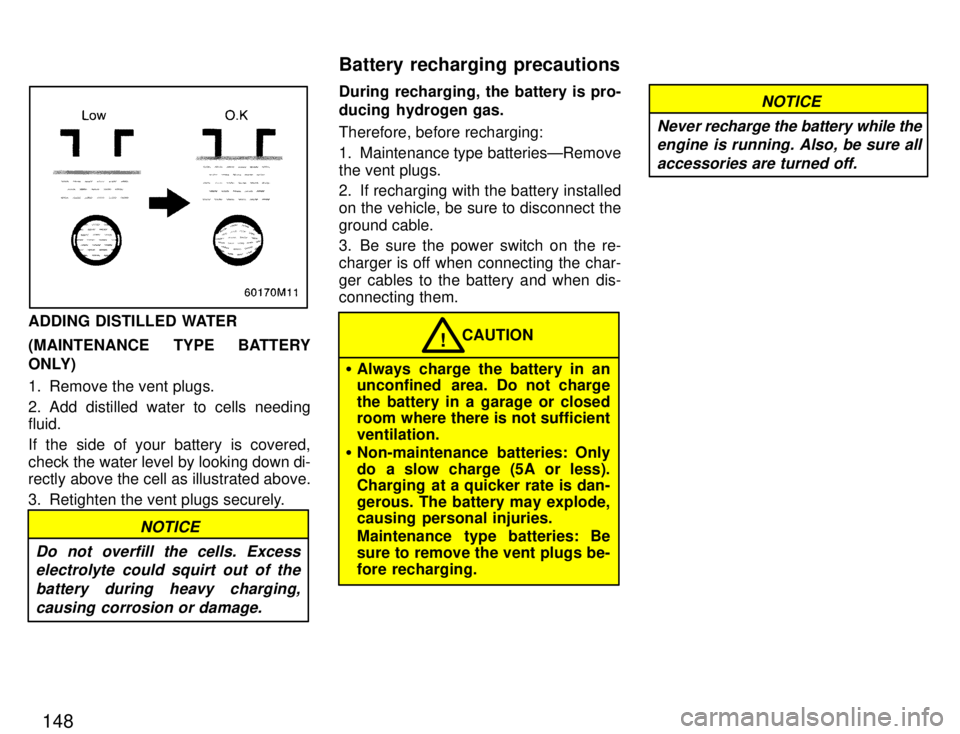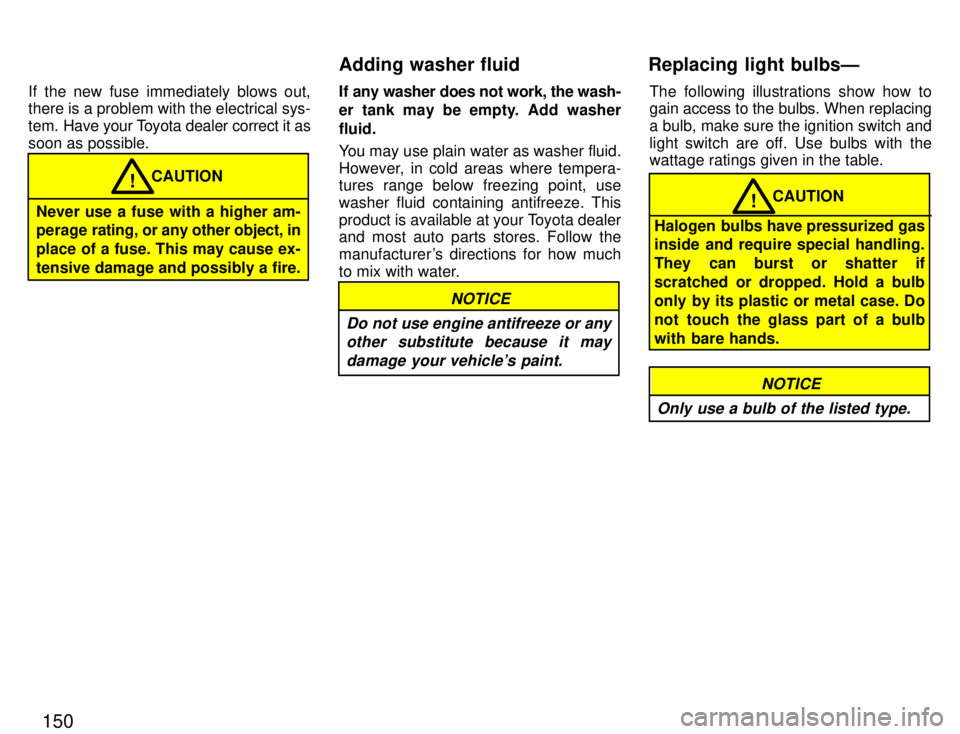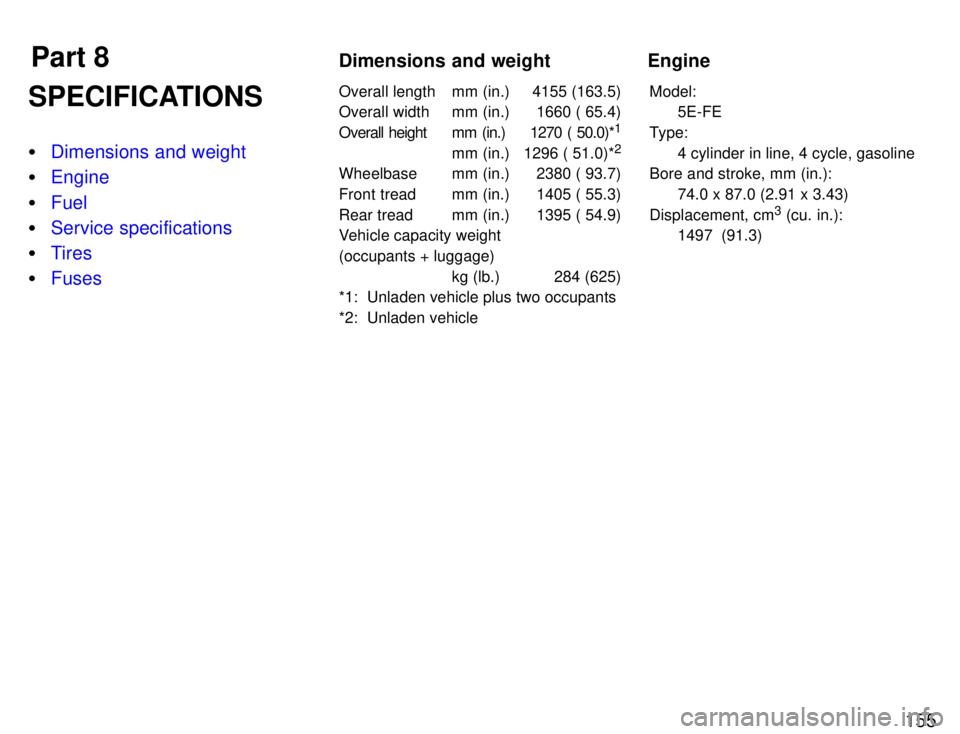TOYOTA PASEO 1996 Owners Manual
Manufacturer: TOYOTA, Model Year: 1996, Model line: PASEO, Model: TOYOTA PASEO 1996Pages: 165, PDF Size: 2.57 MB
Page 151 of 165

148
ADDING DISTILLED WATER
(MAINTENANCE TYPE BATTERY
ONLY)
1. Remove the vent plugs.
2. Add distilled water to cells needing fluid.
If the side of your battery is covered,
check the water level by looking down di-
rectly above the cell as illustrated above.
3. Retighten the vent plugs securely.
NOTICE
Do not overfill the cells. Excess electrolyte could squirt out of the
battery during heavy charging,causing corrosion or damage.
During recharging, the battery is pro-
ducing hydrogen gas. Therefore, before recharging:
1. Maintenance type batteriesÐRemove the vent plugs.
2. If recharging with the battery installed on the vehicle, be sure to disconnect theground cable.
3. Be sure the power switch on the re-
charger is off when connecting the char-ger cables to the battery and when dis-
connecting them.
� Always charge the battery in an
unconfined area. Do not charge
the battery in a garage or closed
room where there is not sufficient ventilation.
� Non-maintenance batteries: Only
do a slow charge (5A or less).
Charging at a quicker rate is dan- gerous. The battery may explode,
causing personal injuries.
Maintenance type batteries: Be sure to remove the vent plugs be-fore recharging. CAUTION
!
NOTICE
Never recharge the battery while the
engine is running. Also, be sure all
accessories are turned off.
Battery recharging precautions
Page 152 of 165

149
If the headlights or other electrical
components do not work, check the
fuses. If any of the fuses are blown,
they must be replaced.
See Fuse locationsº in Chapter 7-1 for
locations of the fuses.
Turn the ignition switch and inopera-
tive component off. Pull a suspected
fuse straight out and check it. Determine which fuse may be causing the
problem. The lid of the fuse box shows the name of the circuit for each fuse. See Part8 of this manual for the functions con-
trolled by each circuit. Type A fuses can be pulled out by
the pull-
out tool. The location of the pull-out tool is shown in the illustration.
If you are not sure whether the fuse has
blown, try replacing the suspected fuse with one that you know is good.
If the fuse has blown, push a new fuse
into the clip.
Only install a fuse with the amperage rat-
ing designated on the fuse box lid.
If you do not have a spare fuse, in an emergency you can pull out the CIG &
RADIOº, DOMEº or A/Cº fuse, which
may be dispensable for normal driving, and use it if its amperage rating is the same.
If you cannot use one of the same amper-
age, use one that is lower, but as close as
possible to the rating. If the amperage is
lower than that specified, the fuse might
blow out again but this does not indicate
anything wrong. Be sure to get the correct
fuse as soon as possible and return the
substitute to its original clip.
It is a good idea to purchase a set of spare
fuses and keep them in your vehicle for emergencies.
Checking and replacing fuses
Page 153 of 165

150
If the new fuse immediately blows out, there is a problem with the electrical sys-
tem.
Have your Toyota dealer correct it as
soon as possible.
Never use a fuse with a higher am-
perage rating, or any other object, in
place of a fuse. This may cause ex-
tensive damage and possibly a fire. CAUTION
!
If any washer does not work, the wash-
er tank may be empty. Add washer fluid.
You may use plain water as washer fluid.
However, in cold areas where tempera-
tures range below freezing point, use
washer fluid containing antifreeze. This
product is available at your Toyota dealer
and most auto parts stores. Follow the
manufacturer 's directions for how much
to mix with water.
NOTICE
Do not use engine antifreeze or any other substitute because it may
damage your vehicle's paint.
The following illustrations show how to
gain access to the bulbs. When replacing
a bulb, make sure the ignition switch and
light switch are off. Use bulbs with the wattage ratings given in the table.
Halogen bulbs have pressurized gas
inside and require special handling.
They can burst or shatter ifscratched or dropped. Hold a bulb
only by its plastic or metal case. Do
not touch the glass part of a bulb
with bare hands. CAUTION
!
NOTICE
Only use a bulb of the listed type.
Replacing light bulbsÐ
Adding washer fluid
Page 154 of 165

151
Light
bulbs
Bulb
No.WType
HeadlightHB260/55A
Parking, front side marker and front turn signal lights115727/8B
Rear side marker lights1685C
Rear turn signal lights115627B
Stop and tail lights115727/8B
Tail light11578B
Back-up lights115627B
License plate lightW5W5C
High mountedstop light*P21W21Bgstop light*115627B
Personal lights-8D
A: HB2 halogen bulbs B: Single end bulbs
C: Wedge base bulbsD: Double end bulbs
*: You may use either a 21w or 27w bulb.
1. Open the hood. Remove the plastic
cover.2. Unplug the connector. Remove the
rubber cover. If the connector is tight, wiggle it.
ÐHeadlights
Page 155 of 165

152
3. Release the bulb retaining spring
and remove the bulb. Install a new
bulb and the bulb retaining spring.
To install a bulb, align the tabs of the bulb with the cutouts of the mounting hole.4. Install the rubber cover with the
TOPº mark upward, and snuggle on
the boss. Insert the connector. Then
install the plastic cover.
Make sure the rubber cover fits snugly on
the connector and the headlight body.
Aiming is not necessary after replacing
the bulb. When aiming adjustment is nec-
essary, contact your Toyota dealer.Use a Phillips-head screwdriver.
ÐParking, front side marker and front turn signal lights
Page 156 of 165

153
a: Tail light
b: Back-up light
c: Stop and tail light
d: Rear turn signal light
e: Rear side marker light
ÐRear side marker, rear turn signal, stop and tail, and back-up lights
Page 157 of 165

154
ÐHigh mounted stoplight
ÐLicense plate lights
Page 158 of 165

Part 8Dimensions and weight Engine
155
SPECIFICATIONS �
Dimensions and weight
�Engine
�Fuel
�Service specifications
�Tires
�Fuses
Overall length mm (in.) 4155 (163.5)
Overall width mm (in.) 1660 ( 65.4)
Overall height mm (in.) 1270 ( 50.0)*
1
mm (in.) 1296 ( 51.0)* 2
Wheelbase mm (in.) 2380 ( 93.7)
Front tread mm (in.) 1405 ( 55.3)
Rear tread mm (in.) 1395 ( 54.9)
Vehicle capacity weight (occupants + luggage) kg (lb.) 284 (625)
*1: Unladen vehicle plus two occupants
*2: Unladen vehicle Model:
5E-FE
Type: 4 cylinder in line, 4 cycle, gasoline
Bore and stroke, mm (in.):
74.0 x 87.0 (2.91 x 3.43)
Displacement, cm 3
(cu. in.):
1497 (91.3)
Page 159 of 165

156
Fuel type:
Unleaded gasoline, Research Octane
Number 91 (Octane Rating 87) or higher
Fuel tank capacity, L (gal., Imp. gal.):
45 (11.9, 9.9) ENGINE
Valve clearance (engine cold), mm (in.)
Intake 0.15 '0.25 (0.006 '0.010)
Exhaust 0.31 '0.41 (0.012 '0.016)
Spark plug type:
NIPPONDENSO K16TR11
NGK BKR5EKB11
Spark plug gap, mm (in.):
1.1 (0.043)
Drive belt tension measured with Bor-
roughs drive belt tension gauge No.
BT-33-73F (used belt), Ibf: 100 + 20
ENGINE LUBRICATION Oil capacity (drain and refill), L (qt., Imp. qt.):
With filter 2.8 (3.0, 2.5)
Without filter 2.6 (2.7, 2.3) Oil grade:
API SH, Energy-Conserving IIº mul-
tigrade engine oil or ILSAC multi-
grade engine oil is recommended.
Recommended oil viscosity (SAE):
COOLING SYSTEM
Total capacity, L (qt., Imp. qt.): Automatic transmission
5.3 (5.6, 4.7)
Manual transmission 4.9 (5.2, 4.3)
Coolant type: With ethylene-glycol antifreeze (Do not use alcohol type.)
Fuel Service specifications
Page 160 of 165

157
BATTERY Open voltage* at 20
5C (68 5F):
12.7 V Fully charged
12.3 V Half charged
11.9 V Discharged
*: Voltage that is checked 20 minutes after the key is removed with all the
lights turned off
Charging rates: 5 A max
CLUTCH
Pedal freeplay, mm (in.):
5' 15 (0.2 '0.6)
Fluid type: SAE J1703 or FMVSS No. 116 DOT 3
MANUAL TRANSAXLE
Oil capacity, L (qt., Imp. qt.): 1.9 (2.0, 1.6)
Oil type: Multipurpose gear oil API GL- 4 or GL- 5
Recommended oil viscosity:
SAE 75W-90
AUTOMATIC TRANSAXLE Fluid capacity (drain and refill), L (qt., Imp. qt.): Up to 3.1 (3.3, 2.7) Fluid type:
Automatic transmission fluidDEXRON [
-
II
BRAKES Minimum pedal clearance when de- pressed with the pressure of 490 N (50 kgf,
110 lbf) with the engine running, mm (in.):
With anti-lock brake system
60 (2.4)
Without anti-lock brake system 55 (2.2)
Pedal freeplay, mm (in.): 1Ð6 (0.04Ð0.24)
Pad wear limit, in. (mm):
1.0 (0.04)
Lining wear limit, in. (mm): 1.0 (0.04)
Parking brake adjustment when pulledwith the force of 196 N (20 kgf, 44 lbf): 5Ð8 clicks
Fluid type: SAE J1703 or FMVSS No. 116 DOT 3
STEERING Wheel freeplay:
Less than 30 mm (1.2 in.)
Power steering fluid type:
Automatic transmission fluid DEXRON [
-
II or -III Tire size:
Spare tireWith anti-lock brake systemT105/70D16
Without anti-lock brake system
T115/70D14
Except spare tire P185/60R14 82H
Tire pressure, kPa (kgf/cm 2
or bar, psi):
Spare tire 420 (4.2, 60)
Except spare tire
183 (1.83, 26)
Wheel size: Spare tire With anti-lock brake system16 x 4T
Without anti-lock brake system
14 x 4T
Except spare tire Aluminum wheels 14 x 5.5JJ
Except aluminum wheels 14 x 5.5J
Wheel nut torque, N Vm (kgf Vm, ft Vlbf):
103 (10.5, 76)
Tires